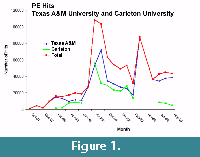Things That Change and Things That Stay the Same
Article number: 2.2.3E
22 October 1999
https://doi.org/10.26879/99003E
Welcome to the new issue of Palaeontologia Electronica! We hope you find it as enjoyable and informative to read as the PE staff and we did putting it together. In this issue, as always, you’ll find a mixture of old and new features but always the same great paleontology.
First, we would like to welcome a new mirror site to the growing PE family, the Australian Geological Survey Organisation. Dr. Jonathon Root of the AGS will be helping us upload and maintain PE issues for our readers in Australia, New Zealand, and the Far East. As you can imagine the ability to have regional access to PE for these paleontologists should make a considerable difference in their download times. With the addition of this site PE continues its tradition of being the most widely available paleontological journal in the world. Thanks to Jonathon and his colleagues and we look forward to working with you.
With this issue we have given ourselves another facelift. One of the first things you will notice is our new layout and graphic design elements. We simply can’t keep our creative little hands off our interface. An advantage of electronic publishing is that it is easy to alter the look and "feel" of a web journal to incorporate changes that increase its utility and user friendliness. Please let us know if there is something you particularly like/dislike about our layout. As the WWW thrives on change there will undoubtedly be continued modifications to our design as the technology improves and bandwidth increases.
Prominent among our new design elements are our Apple QuickTimeTM oral abstracts. These provide audio recitations of the formal and plain language versions of this issue's technical article abstracts, primarily for the benefit of visually-impaired users. However, the technology is interesting in its own right and we encourage readers (and listeners) to try out a few of the abstracts just to see what PE sounds—as well as looks—like. Palaeontologia Electronica’s book reviews and web site review sections have also been expanded.
As with previous issues, PE authors continue to push the boundaries of paleontological publishing. This issue contains some of our most innovative and sophisticated articles yet, including Gordon Curry’s analysis of original coloration patterns in fossil brachiopods from New Zealand, as well as Michael Boulter and Dil Hewzulla’s Java application that allows any user to query and construct Family-level richness, origination, and extinction curves from the online Fossil Record 2 database. In the latter Boulter and Hewzulla also propose a new model for describing diversity changes in the fossil record and speculate as to whether the fossil record can be used to predict the future diversity of extant groups. Best of all, users can replicate, test, and extend Boulter and Hewzulla’s analysis using the software tools provided in their article. That’s a capability print-based journals are going to have a difficult time matching!
 Add all the new features in this issue to PE’s back issue catalog, and it’s little wonder that our access rate (Figure 1) continues to double approximately every six months and peak at the time of a new issue release; two of our nine mirror sites received over 100,00 hits after release of the last two issues. Best of all, our site use record trends show no sign of leveling off. These data suggest that in addition to being the most widely-available paleontological journal, PE is also one of the most popular.
Add all the new features in this issue to PE’s back issue catalog, and it’s little wonder that our access rate (Figure 1) continues to double approximately every six months and peak at the time of a new issue release; two of our nine mirror sites received over 100,00 hits after release of the last two issues. Best of all, our site use record trends show no sign of leveling off. These data suggest that in addition to being the most widely-available paleontological journal, PE is also one of the most popular.
This brings us to our last point—what hasn’t changed at PE. Palaeontologia Electronica maintains its commitment to publishing the best and most innovative paleontological research available. Our commitment to rigorous peer-review review is unshakable and the efforts we make to work with authors to bring the best out in their work is unparalleled. Regardless of whether you are a producer or consumer of paleontological data, commentary, or insight, you need look no further than PE for what is new and exciting in paleontology.
Copyright: Coquina Press, 22 October 1999
http://palaeo-electronica.org

